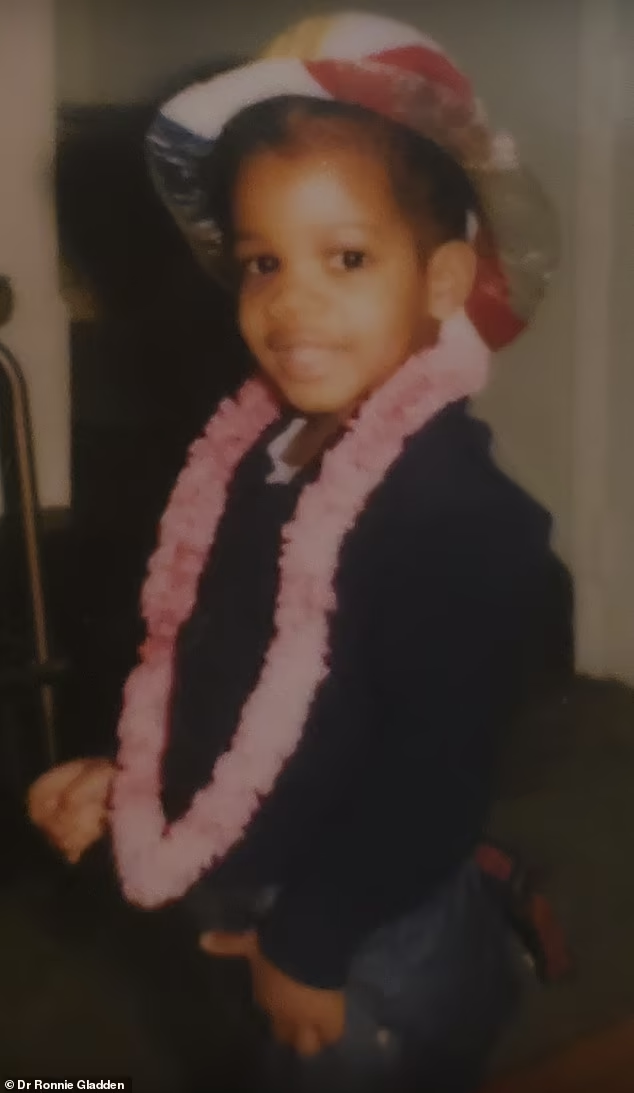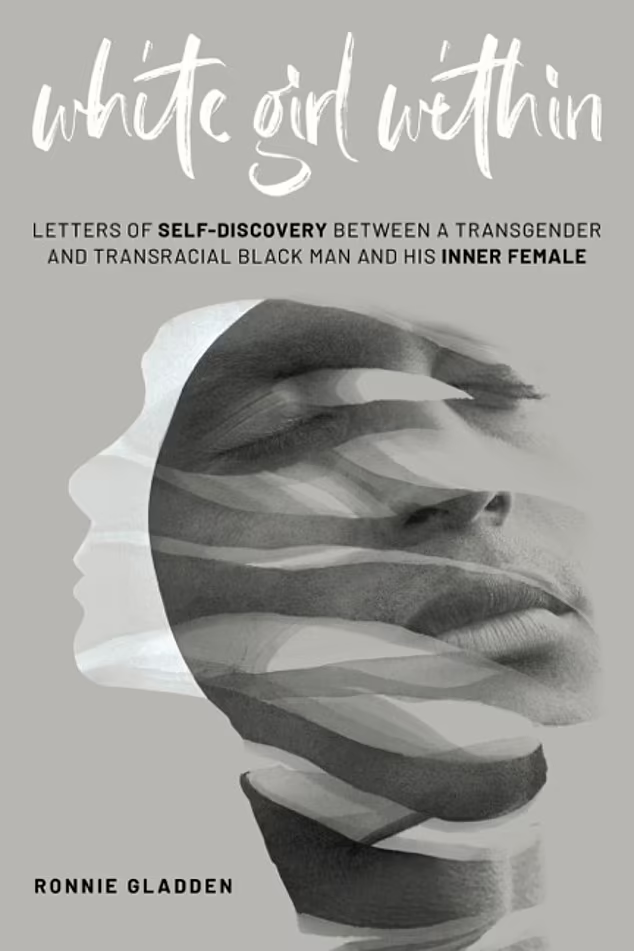Dr. Ronnie Gladden grew up with dreams that mirrored those of many young women: aspiring to be like Snow White, imagining a life straight out of Pride & Prejudice, and admiring the style of Elle Fanning.
He dreamed of sunbathing to achieve a tan and longed for blonde hair that would lighten in the summer.
But these dreams were anything but typical—for Ronnie was a Black boy growing up on the west side of Cincinnati.
Now in midlife, Dr. Ronnie Gladden is a tenured English professor at Cincinnati State Technical and Community College, as well as a public speaker and actor.
They use their platform to advocate for a concept they describe as a “transracial” identity.
Although born Black and male, Ronnie—who uses the pronoun “they”—now identifies as a white woman.
Regardless of outward appearance, they feel a “repressed White female identity” within them, longing for expression.

Ronnie is part of a small, lesser-known community of individuals who identify as “transracial”—meaning they identify as both transgender and transracial.
Transracial individuals believe that race, being a social construct, can be considered a “choice.” However, the concept of “changing” one’s race remains highly controversial.
One widely recognized example of a person identifying as transracial is Rachel Dolezal, a former NAACP leader who, in 2015, was revealed to be a white woman from a predominantly European ancestry.
The revelation sparked worldwide outrage, especially on social media, after Dolezal described race as a “lie.”
In a 2015 interview with BBC’s Newsnight, she argued that ethnicity is not biological and likened being “transracial” to being transgender.
Her statements prompted backlash on X (formerly Twitter), with many accusing her of leveraging “white privilege” to justify her perspective.
Despite the criticism, Rachel remained firm in her transracial identity, describing herself as “unapologetically Black” in a 2019 documentary.
Rachel Dolezal has commended Dr. Ronnie Gladden’s work, stating it “encourages us to expand our concept of acceptance and inclusion.”
Dr. Ronnie, who earned a doctorate in Educational Leadership from Northern Kentucky University, supports the view that there are no innate or biological differences between races.


Ronnie asserts that race is a social construct shaped by how people perceive and treat one another, as well as by how individuals see themselves.
“I know race is not real,” Ronnie writes in their book. “It exists only because society says it does.”
At 19, Ronnie underwent their first cosmetic surgery, including a nose job and “some work on the lips.”
Ronnie also wears foundation in a shade lighter than their natural skin tone, though they recognize that their appearance doesn’t fully convey their internal sense of being a white woman.
“My skin is quite brown in complexion,” Ronnie shared with BBC Radio 4. “My hair is thick, with twists and waves, doing a lot of different things—but I see that as an expression of my mind.”
In the same interview, Ronnie described feeling like a white female as a sense dating back to early childhood.
From as early as preschool, at age four, Ronnie remembers wanting to be like the white girls in their class.
“I remember being outside on the playground, wanting to move in the same way as my classmates—the way their hair would catch in the wind and bounce around. I wanted to have those rosy cheeks,” they explained.
In a TEDx talk, Ronnie further described this inner experience: “I present as Black and male, yet internally, I possess a white girl within.”
Reflecting on these feelings, they continued, “Back then, I knew I was drawn to the white female aesthetic. I felt a magnetic connection to the hair texture, the skin tone, the bone structure, the social cues, and the nuances of it all.”

Ronnie referred to this realization as “surprising, perplexing, daunting, and, to put it mildly, extremely inconvenient.”
In an interview with Medium, they shared that the “psychological burden” of this awareness plunged them into “the depths of depression and a slight oblivion.”
Ronnie noted that some might contend that growing up as a child among predominantly white peers could lead one to feel that this is how they should appear.
Nonetheless, these feelings have persisted into adulthood.
Dr. Gladden endured violence during their childhood and adolescence, including the tragic murder of their half-sister while they were in middle school. Alongside other childhood traumas, the writer has described their father as abusive.
In a poignant revelation, they express a belief that they could have confronted the violence more effectively had they been a white girl, stating, “I thought there was a power in beauty, a power in skin.”
The writer conveys that they could have communicated a message to “back the hell off” with “the kind of authority embodied in white femaleness.”
Ronnie, who has been in therapy for nearly two decades, shared that the process of transitioning from the inside out is something they have contemplated deeply.
They elaborate on this journey in their book, White Girl Within: Letters of Self-Discovery Between a Transgender and Transracial Black Man and His Inner Female.
The book is structured as a series of letters that explore Dr. Gladden’s experiences as both a Black male and a white female.
Reflecting on their upbringing, Ronnie mentions that they saw aspects of themselves mirrored in several women, including Full House’s Kimmy Gibbler, rock star Joan Jett, and actress Anne Hathaway, describing this feeling as “insistent, consistent, and persistent throughout the years.”
They have stated that their extensive education was a journey that significantly bolstered their mental health.
Ronnie participated in International Summer Schools at the University of Cambridge and later pursued a career in academia, traveling extensively to teach, perform, and mentor others.
Although they experienced feelings of identifying as a white female as early as age four, by middle age, Dr. Ronnie reflected on how they were still grappling with “unfinished business” regarding the integration of these distinct identities.
Despite these struggles, Ronnie wrote, “Through all the noir, I know the light of my white femaleness swirls and lurks about. I thought it would always just have to be this way.”
During their TEDx talk, the academic—who frequently discusses identity, diversity, and inclusion in K-12 schools, universities, and nonprofits—addressed how transracial identities have been depicted in popular culture.
Among the examples they cited was Whoopi Goldberg’s portrayal of a white male in the film The Associate.
They also referenced Jennifer Lawrence’s character, Mystique, in the Marvel franchise, noting, “Through her character Mystique, she was able to represent an amalgamation of different kinds of races, ethnicities, and even species.”

In their book, Dr. Ronnie describes their journey to self-identity, stating that they are a female who has been brought into “the time of an adult season.”
However, the path has not been a straightforward one; they acknowledge that their development “was not linear” and that they are still “working to get caught up with everything.”
This ongoing journey includes aspects of their identity such as “my voice, my looks, my actions, my stride—and my time.”
Reflecting on their acceptance of identity, they wrote, “Ronnie, your life and form always eclipses me. It’s true, I’m a white girl. And for the longest time, I’ve been your white girl. I know I’m me because I see it.
“The subtext abounds. It’s those eyes from three-dimensional white females that see me buried in you. Their instinct knows it and feels it.”





